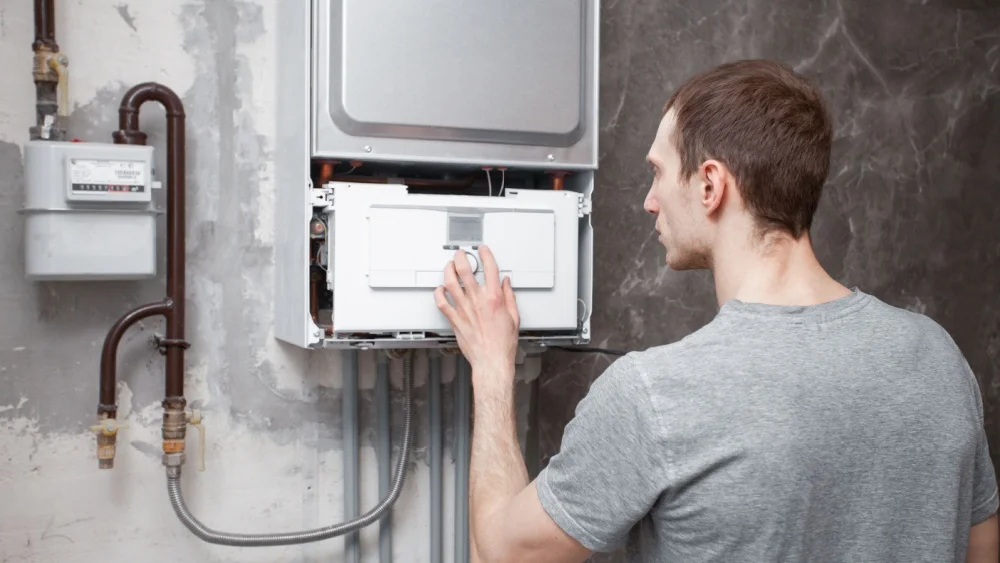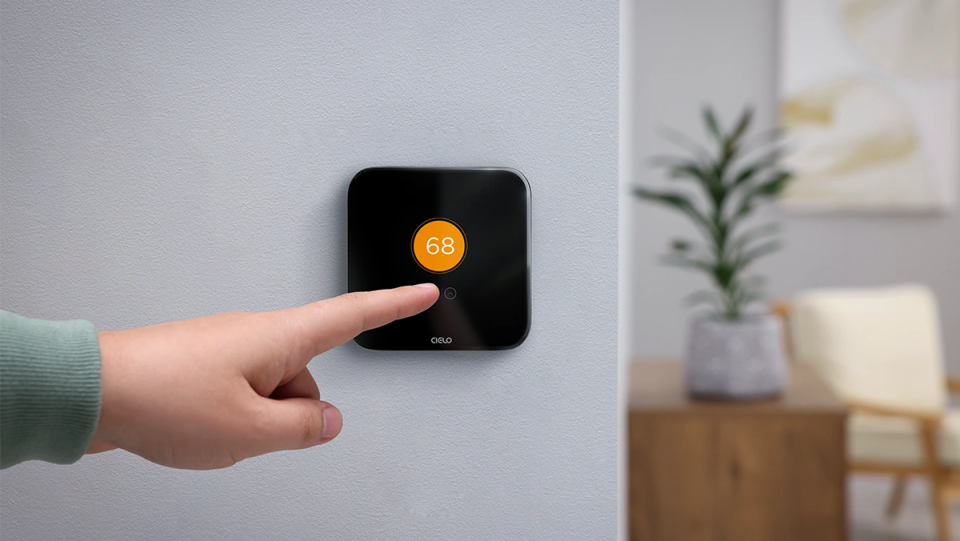
Key Takeaways
- Boiler systems use hot water or steam to heat up your home.
- Regular maintenance tasks like bleeding radiators, descaling, and checking pressure gauges help boost boiler efficiency.
- Annual professional inspections help identify potential issues early, ensuring your boiler runs safely and efficiently.
A boiler is an important system for keeping your home warm and comfortable. However, like any other HVAC system, regular maintenance is required to work efficiently. Neglecting its upkeep can lead to reduced performance, increased energy bills, and a higher risk of breakdowns.
This guide covers a range of boiler maintenance tasks that you can do on your own, from bleeding radiators to checking the water level. It also explains what is involved in a professional inspection, detailing the steps a technician takes to ensure your boiler is working properly and safely.
The Basics of a Boiler System
A boiler is a type of heating system that generates hot water or steam to warm up your home. A circulating pump pushes the hot water/steam through a network of pipes to the radiator units installed in each room. The heat is given up at the radiators, and the water moves back to the boiler to be heated again. The radiators transfer the heat to the air through a process called convection. Boilers can be powered by various fuel sources, including oil, gas, propane, or electricity.
Related: What Is a Hydronic Heating System? Is It an Effective & Efficient Heating Option?
Advantages of Boiler System
- Unlike forced air heating systems, boilers don’t circulate dust, which helps maintain good indoor air quality.
- They offer consistent and uniform heating throughout the home, preventing hot and cold spots in your home.
Related: Furnace vs. Boiler: What’s the Difference & Which One Is Right for Your Home?
Disadvantages of Boiler Unit
- Boiler systems are complex to install as they require labor-intensive tasks like modifying or upgrading your plumbing and installing radiators in each room. Moreover, the installation must meet strict building codes and efficiency standards, which may require additional professional inspections.
- They take up more space, and you need a proper space to keep them.
DIY Boiler Maintenance Tasks

Here is a DIY boiler maintenance checklist that you can follow to keep your unit in top shape and prevent costly repairs.
1. Check the Water Level
Maintaining the correct boiler water level ensures both efficient heating and safe operation. Check the glass gauge on your boiler. Excessively high water levels can lead to inefficient steam production, while low levels risk overheating the system. Adjust the water levels by adding or draining water as needed.
Note: Be careful not to overfill, as this will force water out of the header instead of steam, which can be dangerous.
2. Bleed the Radiator
Air pockets accumulate in the radiator over time, and they need to be released to ensure efficient boiler performance. Trapped air makes it harder for the boiler to heat your home.
Open the air bleed valve on each radiator using the radiator key until the air is released. You will hear the hissing sound as the air releases. When the hissing stops and you notice water coming out, close the valve. Clean the leaked water from the floor. You can perform this boiler maintenance task once every quarter.
3. Install a Smart Thermostat
If you have a manual thermostat, your boiler might struggle to adjust to different temperature preferences or changes, leading to uneven heating. A smart thermostat can help deal with this. Plus, you can even schedule your preferred temperatures for different times of the day. This not only helps your boiler operate more efficiently but also reduces energy consumption, saving you money on heating costs.
Equip your HVAC system with smart features and achieve the perfect balance between comfort & savings.
Learn more
4. Check for Leaks
The heat exchanger is the component where the water is heated, so look for water around that area. If there are puddles around it, you will have to call in a pro for heat exchanger replacement. Water can lead to mineral buildup and corrosion of internal parts.
5. Clean the Filters
Regularly cleaning and replacing filters helps keep your boiler running smoothly and prevents unnecessary energy consumption.
Check your boiler manual to see how to remove them from the unit. Then, hose them down with a high-powered sprayer to remove all the dirt buildup. Put them back inside once they are fully dry.
6. Inspect Vents & Chimney
As air flows through vents and chimneys, dirt and debris can gradually build up inside them. Regularly inspect these areas and clean out any buildup using a dust cover. Additionally, check for holes and gaps in the chimney and where vents meet the boiler to make sure the connection is secure.
7. Descale the Boiler
Descaling, also called flushing, is a highly important boiler maintenance task. This process helps to remove the water-sediment buildup.
To perform this task, turn off your boiler and put protective sheets around it to absorb the water. Then, let the boiler drain completely so it flushes out. Refill it using a hose or any other water source. Turn on the boiler and enjoy the cozy warmth!
8. Check the Color of the Boiler Flame
The boiler flame, often called the pilot flame, should always burn blue. A flame that appears orange, yellow, or smoky gray signals a problem within the system.
To inspect the flame, open the boiler’s front panel and observe its color. If you notice any color issues, contact your local boiler technician for an inspection.
9. Adjust the Pressure Gauge
Adequate hot water pressure is necessary for smooth boiler operation. Check it at least once a week and adjust it if it’s too low or high. It should be between 1 to 2 bars.
10. Leave the Registers Open
Vents or registers should never be closed completely, as this harms heating efficiency. To ensure even heat distribution, keep them at least 20% open.
11. Ensure Proper Boiler Circulation
Look for any gaps and cracks in your boiler insulation at least once a month and fix them promptly. Poor insulation can cause heat to escape before it reaches your home, reducing efficiency.
12. Oil the Circulating Pump
The boiler circulating pump should be kept well-oiled so it effectively circulates hot water to the individual radiator units. The boiler has an oil cup, and you can add oil to it to keep the pipe lubricated.
13. Ensure Proper Ventilation Around the Boiler
Make sure that the room where you installed the boiler isn’t crowded and that there is plenty of space around it. Also, it should be 27 inches from the wall, and there shouldn’t be anything on top of that.
14. Lag the Pipes
In extreme cold, there’s a risk of your pipes freezing and bursting, which will not only create a mess but also be expensive to fix. To prevent this, you can lag the boiler pipes. Buy some lagging material from your local hardware store and wrap it around the pipes.
Professional Boiler Maintenance
In addition to regular maintenance tasks, you should also have a professional inspect your boiler annually to ensure it is in good condition. You can also call a technician if you encounter any issues during the DIY task.
During the inspection, the technician will follow the checklist that includes:
- Inspect boiler pressure levels and ensure that they are within safe operating levels.
- Opening the drain valve to flush out the accumulated sediment until the clear water starts flowing. Sludge and sediment buildup can increase fuel consumption and pose a fire hazard.
- Checking the pipes for water or steam leakage. Leaks can result in water damage and decreased boiler efficiency.
- Inspecting the flue gas vent and fuel tank for any sign of wear or tear and leakage. Addressing these issues promptly helps reduce the risk of fire.
Related: Home Heating Safety: 15 Top Fire Prevention Tips Every Homeowner Should Know
- Tuning the burners and making sure they are clean for efficient combustion.
- Test the proper functioning of safety valves, control valves, and shut-off valves. Safety valves will be tested under pressure to ensure they open at the set pressure.
- Cleaning or replacing the pilot assembly to ensure consistent ignition.
- Testing the combustion motor and pressure switch for proper operation.
- Clean the boiler cabinet and flush out any sludge or sediment during the blowdown process.
- Verify that the pressure and temperature readings are accurate and within the recommended range.
- Clean the pilot assembly, gas orifice, and flame sensor to maintain reliable ignition.
In Conclusion
Regular boiler maintenance is essential to ensure the longevity, efficiency, and safety of your heating system. By following the DIY maintenance tasks, such as checking water levels, inspecting for leaks, bleeding radiators, and descaling, homeowners can prevent common issues and maintain optimal boiler performance. However, some tasks, like inspecting flue gas vents or testing safety valves, are best left to professionals during an annual check-up. By combining regular DIY maintenance with professional inspections, you can enjoy peace of mind and efficient heating for years to come.
Frequently Asked Questions
What Are the Common Signs That You Have a Boiler Problem?
- You notice water leakage around your boiler. This can lead to water damage in your house and malfunction of electrical connections near the boiler.
- Frequent boiler repairs and services. - High energy bills without any apparent cause.
- Your burner is taking longer to heat your house despite the same temperature settings. - You notice an unusual smell coming from the boiler.
What Is the Average Life Expectancy of Boilers?
Older boiler systems can last half a century as they are made of ultra-durable cast iron. Modern systems are made of steel alloy and last 25 to 30 years.








